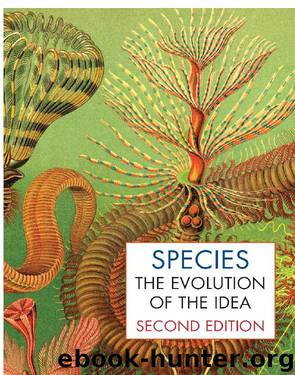Species by John S. Wilkins

Author:John S. Wilkins
Language: eng
Format: epub
Tags: The Evolution of the Idea
Published: 2018-01-31T10:15:20+00:00
up of species.
Weismann appears to think that entire species transmute and are changed into
new species after a period of fragmentation of forms. However, he realizes that spe-
cies are variable:
But of course species are not exclusively complicated systems of adaptations, for they
are at the same time ‘variation complexes,’ the individual components of which are
not all adaptive, since they do not all reach the limits of the useful or the injurious.117
He recognizes that selection applies to sub-organismic “vital units,” and that there
are “indifferent characters,” or non-adaptive characters, which result as by-products,
as it were, of selection for “a harmonious whole.” Selection in the “germ plasm” may
… give rise to correlative variations in determinants next to them or related to them in
any way, and that these may possess the same stability as the primary variation. This
seems to me sufficient reason why biologically unimportant characters may become
constant characters of the species.118
113 Op. cit., vol. II, 305.
114 Op. cit., vol. II, 307.
115 Mazumdar 1995 gives details of Nägeli and Schleiden’s views on species. Nägeli’s [1898] account of species relied upon there being a mechanical “idioplasm” or reproductive plasm.
116 Op. cit., vol. II, 306.
117 Op. cit., vol. II, 307.
118 Op. cit., vol. II, 308.
186
Species
An example of this is the vestigial hind limbs in the Greenland whale.119 So
Weismann was not exactly the panadaptationist he is sometimes made out to be,120
and he also allowed for the existence of neutral characters. However, he rejected
outright the views of those who thought that isolation was a precondition to new spe-
cies and that the characters that formed them were in any way neutral. In discussing
variation, he notes that
… there are very variable species and very constant species, and it is obvious that
colonies which are founded by a very variable species can hardly ever remain exactly
identical with the ancestral species; and that several of them will turn out differently,
even granting that the conditions of life be exactly the same, for no colony will contain
all the variants of the species in the same proportion, but at most only a few of them,
and the result of mingling these must ultimately result in the development of a some-
what different form in each colonial area.121
This is in some ways an early forerunner of the “founder effect” conception of
the origin of new species proposed by Mayr and developed further by Hampton
Carson.122 What is most striking about this is that Weismann is effectively ascrib-ing speciation in this case to stochastic sampling. This is something that, as the
strict selectionist Romanes held him to be, he should not have adopted. Weismann
opposed, though, an exclusivist position such as that of Wagner’s that all species had to be formed in this way.
BIBLIOGRAPHY
Amundson, Ron. 2005. The Changing Role of the Embryo in Evolutionary Biology: Structure
And Synthesis, Cambridge Studies in Philosophy and Biology. New York: Cambridge
University Press.
Barlow, Nora, ed. 1967. Darwin and Henslow: The Growth of an Idea; Letters, 1831–1860.
London: Murray for Bentham-Moxon Trust.
Beatty, John. 1985. Speaking of species: Darwin’s strategy. In The Darwinian Heritage, edited by David Kohn. Princeton PA: Princeton, University Press.
Bernardi, G. et al.
Download
This site does not store any files on its server. We only index and link to content provided by other sites. Please contact the content providers to delete copyright contents if any and email us, we'll remove relevant links or contents immediately.
Sapiens: A Brief History of Humankind by Yuval Noah Harari(14166)
The Tidewater Tales by John Barth(12576)
Mastermind: How to Think Like Sherlock Holmes by Maria Konnikova(7164)
Do No Harm Stories of Life, Death and Brain Surgery by Henry Marsh(6840)
The Thirst by Nesbo Jo(6763)
Why We Sleep: Unlocking the Power of Sleep and Dreams by Matthew Walker(6557)
Life 3.0: Being Human in the Age of Artificial Intelligence by Tegmark Max(5405)
Sapiens by Yuval Noah Harari(5264)
The Longevity Diet by Valter Longo(4994)
The Body: A Guide for Occupants by Bill Bryson(4887)
The Rules Do Not Apply by Ariel Levy(4789)
The Immortal Life of Henrietta Lacks by Rebecca Skloot(4447)
Animal Frequency by Melissa Alvarez(4365)
Why We Sleep by Matthew Walker(4317)
The Hacking of the American Mind by Robert H. Lustig(4265)
Yoga Anatomy by Kaminoff Leslie(4248)
All Creatures Great and Small by James Herriot(4190)
Double Down (Diary of a Wimpy Kid Book 11) by Jeff Kinney(4145)
Barron's AP Biology by Goldberg M.S. Deborah T(4062)
